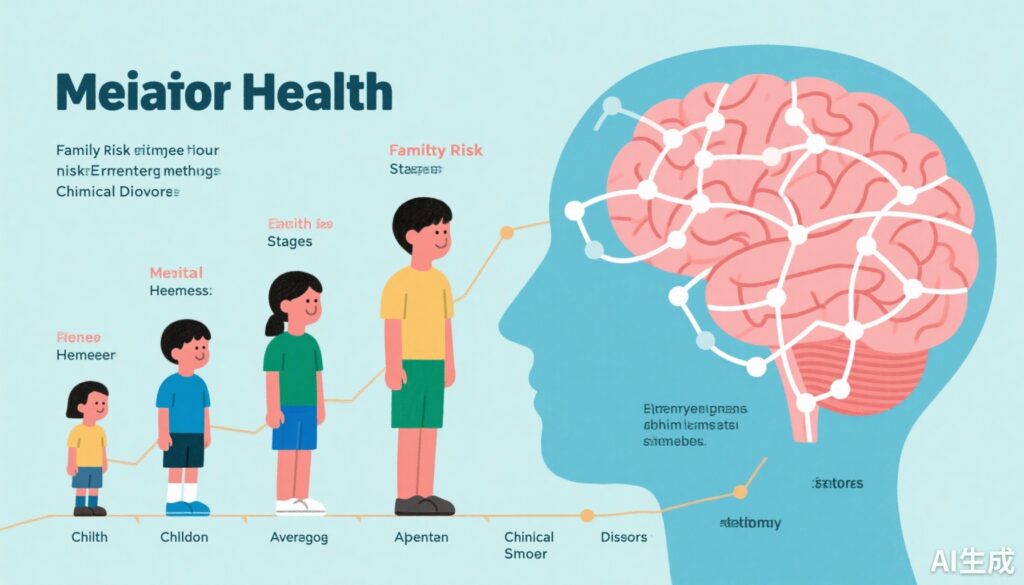Highlights
- Longitudinal evidence supports staged progression from familial risk (stage 0) through mild adolescent symptoms (stage 1a) to clinically significant young adult symptoms (stage 1b), independent of early confounders.
- Neuroticism mediates a significant portion of symptom progression, emphasizing personality traits as potential intervention targets.
- Transdiagnostic prodromal features are largely shared across severe mental disorders, supporting transdiagnostic and staging-based early detection and intervention strategies.
- Integration of clinical staging with neurobiological and phenomenological dimensions reinforces the utility of high-resolution phenotyping for understanding psychopathology trajectories.
Background
Mental disorders impose a substantial global health burden and often present with overlapping symptoms across traditional categorical diagnoses. Clinical staging models, particularly transdiagnostic frameworks, offer a dynamic approach to characterizing early and evolving psychopathology by delineating progression from at-risk states to full-threshold disorders. While transdiagnostic staging models have garnered increased interest, their foundational assumptions—such as whether progression across stages occurs independently of preexisting risk factors—remain underexplored. Understanding how familial risk, early symptoms, and neurodevelopmental traits influence disease trajectories is crucial for optimizing early intervention and preventive care in psychiatry.
Key Content
Evidence From Longitudinal Cohort Studies on Transdiagnostic Stage Progression
The Avon Longitudinal Study of Parents and Children (ALSPAC), a prospective population-based cohort in the UK, provides robust data across developmental periods (Ratheesh et al., 2025). Analysis of 7342 weighted participants revealed that childhood familial risk for schizophrenia or severe depression (stage 0) significantly predicted mild adolescent symptoms of depression, anxiety, or psychosis (stage 1a) with an adjusted odds ratio (OR) of 1.65 (95% CI, 1.30-2.11). Subsequently, stage 1a symptoms predicted clinically significant symptoms in young adulthood (stage 1b) with an OR of 2.07 (95% CI, 1.07-4.01), independent of confounders including demography, family adversity, temperament, and early neurocognition. Notably, adolescent neuroticism mediated 18% of this progression, highlighting personality traits as modifiable pathways.
Large-scale electronic health record analyses employing natural language processing have characterized the transdiagnostic prodrome across severe mental disorders (SMDs), including unipolar and bipolar mood disorders and psychotic disorders (Marwaha et al., 2025). Temporal network analyses revealed mostly shared prodromal features, such as aggression and tearfulness, intensifying closer to disorder onset. Minimal differences emerged between SMD subtypes, except for positive symptoms (e.g., delusions, hallucinations), underscoring the validity of transdiagnostic early risk states with overlapping symptomatology.
Prospective Brazilian cohorts studying executive functioning impairments have shown bidirectional associations between cognitive deficits and psychopathology during adolescence, supporting dynamic processes underlying symptom progression and persistence (de Oliveira et al., 2025). Concurrently, studies examining adverse childhood experiences (ACEs) in transdiagnostic frameworks confirm that trauma exposure significantly elevates risk for later stage 1b+ symptomatology, with effect modification by sex and personality traits, emphasizing the role of environmental and individual vulnerability factors.
Neurobiological and Phenomenological Correlates of Transdiagnostic Stages
Neuroimaging investigations in birth cohorts have linked general psychopathology (p factor) scores with structural alterations in cerebello-thalamo-cortical circuits and visual association cortex (Romer et al., 2021), implicated in executive control. Similarly, functional brain network topography in early adolescence correlates with polygenic risk scores for transdiagnostic psychopathology (Jones et al., 2025), providing a biological substrate to clinical staging.
Moreover, integrating clinical staging with phenomenological domains—selfhood, embodiment, affectivity—has been proposed to refine high-resolution clinical phenotypes useful for individualized prognosis, treatment, and etiological understanding (Fusar-Poli et al., 2021).
Clinical Implications and Predictive Utility
Clinical severity and instability trajectories, measured by instruments like the Clinical Global Impression Severity scale, independently predict six-month hospitalization risk across diverse psychiatric diagnoses, reinforcing the transdiagnostic utility of staging frameworks for prognosis and resource allocation (Nelson et al., 2023). Moreover, dimensional narcissism facets influence depressive symptom severity and treatment response in transdiagnostic adult samples, highlighting the relevance of personality traits across clinical stages and treatment modalities.
Evidence also supports that reason-based cognitive biases (e.g., jumping to conclusions) contribute to progression and persistence of psychotic symptoms, further validating cognitive mechanisms involved in stage transitions (van Os et al., 2021).
Expert Commentary
Current evidence robustly supports the assumption of progressive clinical staging in youth mental health independent of early life confounders. The findings underscore neuroticism and other personality traits as partial mediators, inviting therapeutic targeting. The largely shared prodromal features across psychiatric spectra rationalize transdiagnostic early intervention services rather than disorder-specific approaches. Integration of phenomenological insights with staging further enhances phenotypic precision.
Nonetheless, challenges remain regarding heterogeneity within stages, variable prodrome durations, and individual biological underpinnings. Neuroimaging correlates provide promising biomarkers but require replication and elucidation of longitudinal interplay with symptom progression. The influence of environmental exposures such as ACEs, social factors, and resilience traits necessitate deeper modeling. Moreover, translation to clinical practice demands refined, scalable assessment tools for staging and monitoring.
Guidelines increasingly recognize the value of early clinical staging models while emphasizing systematic longitudinal assessment and tailored interventions. Future research must leverage multimodal data, integrate genetic and environmental risk, and adopt dynamic modeling to optimize preventive psychiatry.
Conclusion
Collectively, longitudinal cohort and electronic health record studies substantiate the progressive nature of transdiagnostic clinical stages from childhood through young adulthood. These transitions occur independently of traditional confounders but are mediated partially by personality and neurocognitive traits. Shared prodromal features across psychiatric disorders endorse transdiagnostic preventive frameworks. Advances in neurobiological characterization and integration of phenomenological depth promise refined clinical phenotyping and more precise prediction models. Implementation of comprehensive staging assessment aligned with these findings can improve early identification, resource allocation, and ultimately patient outcomes.
References
- Ratheesh A, Chen Y, Hammond D, et al. Progression of Transdiagnostic Stages From Childhood to Young Adulthood. JAMA Psychiatry. 2025 Sep 24:e252648. doi:10.1001/jamapsychiatry.2025.2648. PMID: 40991272; PMCID: PMC12461601.
- Marwaha S, et al. Longitudinal evolution of the transdiagnostic prodrome to severe mental disorders: a dynamic temporal network analysis informed by natural language processing and electronic health records. Mol Psychiatry. 2025 Jul;30(7):2931-2942. doi: 10.1038/s41380-025-02896-3. PMID: 39843546.
- de Oliveira LS, et al. Investigating risk factor and consequence accounts of executive functioning impairments in psychopathology: an 8-year study of at-risk individuals in Brazil. Psychol Med. 2025 Jul 14;55:e192. doi: 10.1017/S0033291725100639. PMID: 40653810.
- Jones HJ, et al. Polygenic Risk, Psychopathology, and Personalized Functional Brain Network Topography in Adolescence. JAMA Psychiatry. 2025 Sep 1;82(9):905-915. doi: 10.1001/jamapsychiatry.2025.1258. PMID: 40560555.
- Romero MJ, et al. Replicability of structural brain alterations associated with general psychopathology: evidence from a population-representative birth cohort. Mol Psychiatry. 2021 Aug;26(8):3839-3846. doi: 10.1038/s41380-019-0621-z. PMID: 31796893.
- Fusar-Poli P, et al. Integrating clinical staging and phenomenological psychopathology to add depth, nuance, and utility to clinical phenotyping: a heuristic challenge. Lancet Psychiatry. 2021 Feb;8(2):162-168. doi:10.1016/S2215-0366(20)30316-3. PMID: 33220779.
- Nelson B, et al. Early trajectory of clinical global impression as a transdiagnostic predictor of psychiatric hospitalisation: a retrospective cohort study. Lancet Psychiatry. 2023 May;10(5):334-341. doi: 10.1016/S2215-0366(23)00066-4. PMID: 36966787.
- van Os J, et al. The jumping to conclusions reasoning bias as a cognitive factor contributing to psychosis progression and persistence: findings from NEMESIS-2. Psychol Med. 2021 Jul;51(10):1696-1703. doi:10.1017/S0033291720000446. PMID: 32174291.
- Kotov R, et al. Psychiatric disorders and risk for multiple adverse outcomes: a national prospective study. Mol Psychiatry. 2021 Mar;26(3):907-916. doi:10.1038/s41380-019-0459-4. PMID: 31350462.
- Newbury JB, et al. Adverse childhood experiences and their differential relationships with transdiagnostic mental health outcomes in young adults. Psychol Med. 2025 May 22:55:e147. doi:10.1017/S0033291725000893. PMID: 40400444.



